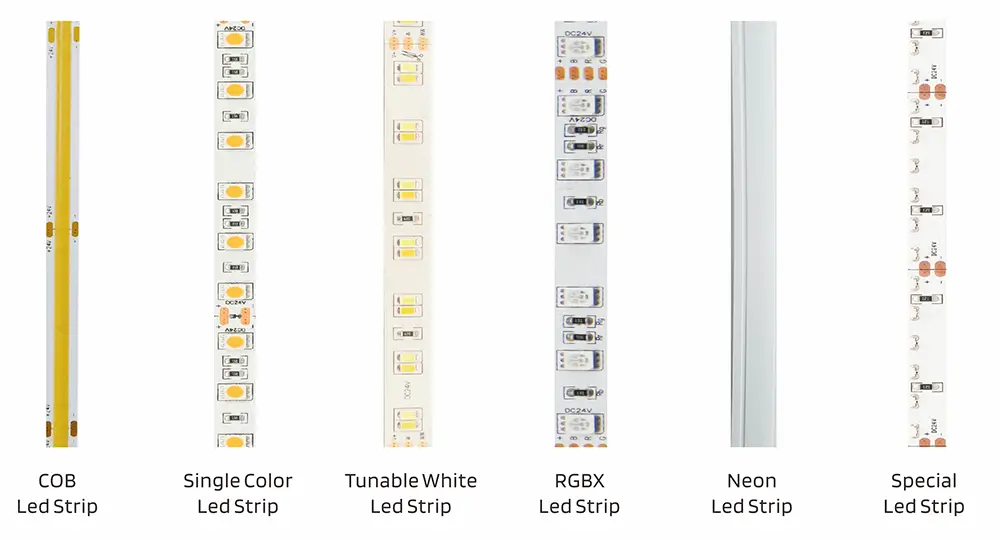
LED strips are becoming more and more popular in architectural and home lighting, and I’m sure you’ve long heard the argument that LEDs are better than incandescent or even halogen bulbs: they’re brighter, more efficient, last longer, and don’t Excessive heat generation, easy control and programming, and more. LED strips are now no longer limited to pure lighting, LED strips can participate in lighting systems in many forms and are an affordable option for commercial and residential lighting applications. When we buy LED strips, we need to consider many factors to ensure we get the right type of LED strip for your needs. I hope you read this article Top Guide on When You Buying LED Strip Lights.
Table of Contents
1 Get a clear vision first!
2 Types of LED Strips
3 The Voltage of your LED Strip
4 LED Strip brightness
5 LED strip Wattage
6 LED Strip Colors
7 LED Length
8 Waterproof LED Strip or Not
9 Which LED Strip should I Choose?
Get a clear vision first!
Because each project is unique, there is no all-in-one solution. Different projects require different types of LED strips. Answer the questions below in your head before starting any project.
Where are you installing the LED Strip?
What exactly do you want to light?
Are the LED Strip installed indoors or outdoors?
How about the length per reel?
How about the CRI?
How many leds per meter?
What is the wattage per meter?
Do you need it in non-waterproof or waterproof?
Types of LED Strips
LED strips are a broad term that includes many different types of LED strips. You can view by wattage, color temperature and model. We classify according to the characteristics of the products, there are COB LED Strip, Mono LED Strip, Tunable white LED Strip, RGB light strips, RGBW LED Strip, RGBTW LED Strip, Neon LED Strip, Special LED Strip.
The Voltage of your LED Strip
Most LED strips come in standard voltages of 12V or 24V. You can decide what type of band you need depending on the place you want to install it on.
LED Strip brightness
As LED technology continues to improve, more super brightness led strip has come out, but in some cases, you might not even want the light too bright. So you’ll want to research lumens/length and LED/length for each strip.
LED strip Wattage
Wattage is an important key to choosing the right LED strip. First you need to know how many watts/m of led strip you want, then you should consider the power supply, so you can easily know if this light strip is suitable for your lighting project.
LED Strip Colors
Our LED strips are available in a variety of mono/bi-color and multi-color strips (RGB or RGBW). The most basic LED strips are our single color that we offer: Warm White, White, Cool White, Red, Green, Blue, Yellow, Pink and Ultraviolet (UV), also RGB strips which is the most common color changing lights we carry around. If you need to be able to produce normal white at the same time, you can choose RGBW LED strips.
LED Length
When buying LED strips, it is important to look at the number of LEDs per length. If the LEDs are spaced too far apart on the strip, they can produce speckled lighting instead of a clean, constant light.
Waterproof LED Strip or Not
If you are installing LED strips indoors, you can choose IP20 non-waterproof, or IP65 silicone gel, IP65 heat shrink tube, if outdoors, it is recommended that you choose IP65 or higher LED strips, IP67 silicone tube and IP68 silicone filling.
Which LED Strip should I Choose?
COB LED Strip: Super narrow 4mm/8mm/10mm optional, uniform light, no lighting spots.
Single Color LED Strip: High CRI/High Density/High brightness/more color temperature.
RGBX LED Strip: RGB/RGBW/RGBTW led strip Best of all worlds.
Special LED Strip: S shaped led strip/dim to warm led strip/side emitting led strip/mini-cutting led strip so on.
